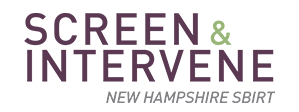Brief Intervention
OVERVIEW
The term, brief intervention, encompasses a number of responses by the provider to the patient following screening. This is a conversation in which the healthcare provider understands level of risk indicated by the results of the screening, a patient’s readiness to change, a patient’s specific needs and life circumstances, and the need for follow up to actively facilitate positive change.
Brief Intervention encompasses positive reinforcement, brief advice and brief intervention, lasting from a few minutes to several conversations with the provider, as described below. Brief intervention is not treatment. It is a patient-centered response, ideally a conversation between the healthcare provider and patient, that utilizes motivational interviewing techniques to:
- Educate regarding safe(r) levels of use.
- Increase awareness of the (potential) health consequences of current use.
- Motivate towards changing risky using behavior.
- Support the patient in making choices that reduce their risk of problems related to substance use and/or developing a chronic substance use disorder.
| Purpose of Play 6 | To understand Brief Intervention as part of the S·BI·RT process. |
| Definitions | Positive Reinforcement: When a youth screens as “no current use,” this is a negative screen. Positive reinforcement is an important acknowledgement of healthy behavior. It can be as simple for younger adolescents as “I see that you report not using any alcohol or other drugs. Most people your age do not, and I’m really glad to see you are making this choice for your health and safety.” For later adolescence, a provider may inquire, “Do you have friends that have used alcohol or other drugs? What do you say to them to let them know you do not want to?” This unique prevention opportunity is a key benefit of the S·BI·RT approach.Brief Advice: When the results of the screen are positive, indicating current use that is infrequent or less than once per month, with no apparent evidence of a substance use disorder, brief advice is warranted. This very quick follow up acknowledges the positive screen, explains the risks of substance use to the developing brain, advises against further use, and facilitates development of strategies to support abstinence.Brief Intervention: When the screening indicates a youth is at moderate or high risk, drinking or using other drugs once per month or more, a brief intervention is indicated. Practitioners are trained to engage in a different kind of conversation using simple motivational interviewing techniques. When the use suggests a mild to moderate risk, the goal of the conversation is to increase awareness of problematic substance use, encourage reduction in use, and changes to risky behavior. Severe substance use, characterized in adolescents as using weekly or more frequently, often necessitates a referral for evaluation, diagnosis, and treatment. The brief intervention conversation is required to engage the patient in the decision to participate in further evaluation and to actively facilitate a successful referral. This may take several follow-up conversations between provider and patient and often necessitates parental engagement – with the youth’s permission when at all possible. |
| Team members | All team members need to understand what brief intervention encompasses. This is vital to later integration of documentation into the EHR and determination of flow. |
| Measure(s) |
|
Recommended Approach
- Review recommended brief intervention techniques and tools for the chosen population. Example Brief Intervention Dialogue is available in Appendix J.
- Discuss potential pros/cons of suggested brief intervention techniques and impacts on flow. For example, how long is the screening process, who is conducting the BI, how is documentation done, and how is follow captured?
- Brief intervention by the medical practitioner is ideal – if flow and resources can accommodate.
- Training in brief intervention is imperative to receive consistent quality results. Brief Intervention Tools are available in Appendix K.
Keep In Mind
- Consultation and training on brief intervention is available through the Center.
- Techniques are evidence-based and incorporate motivational interviewing techniques. MOTIVATIONAL INTERVIEWING EXPERTISE IS NOT REQUIRED.
- Confidentiality considerations must be incorporated into every step of the brief intervention process. Where is the BI information documented in EHR? How is follow-up appointment scheduling explained to the parent?
- Remember, the screening tools augment but do not replace a provider’s clinical judgement and knowledge of the youth and family. For some youth, infrequent substance use may require brief intervention more than brief advice.
Corresponding Appendix Section(s)
Appendix J – Example Brief Intervention Dialogue
Appendix K – Brief Intervention Tools
